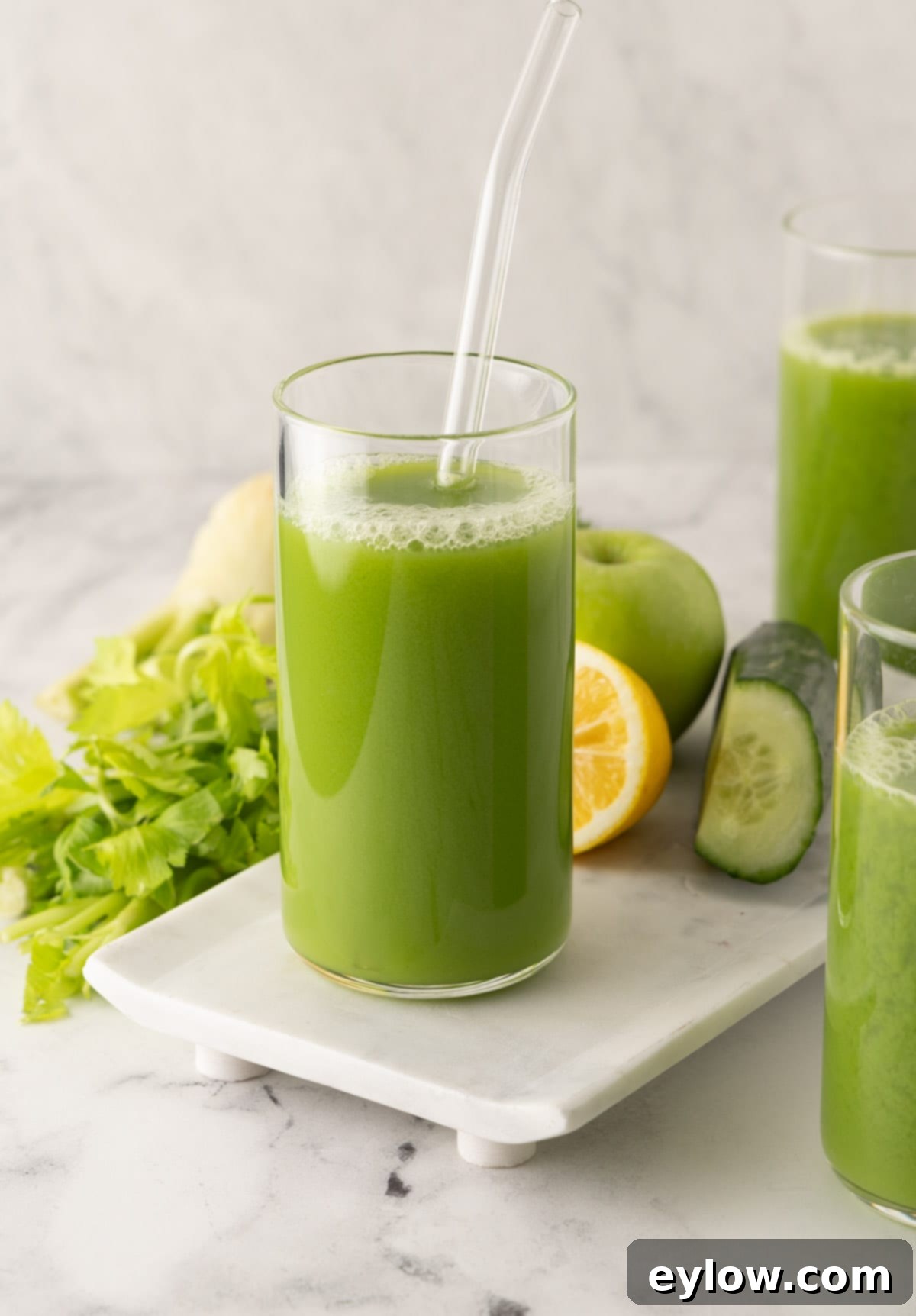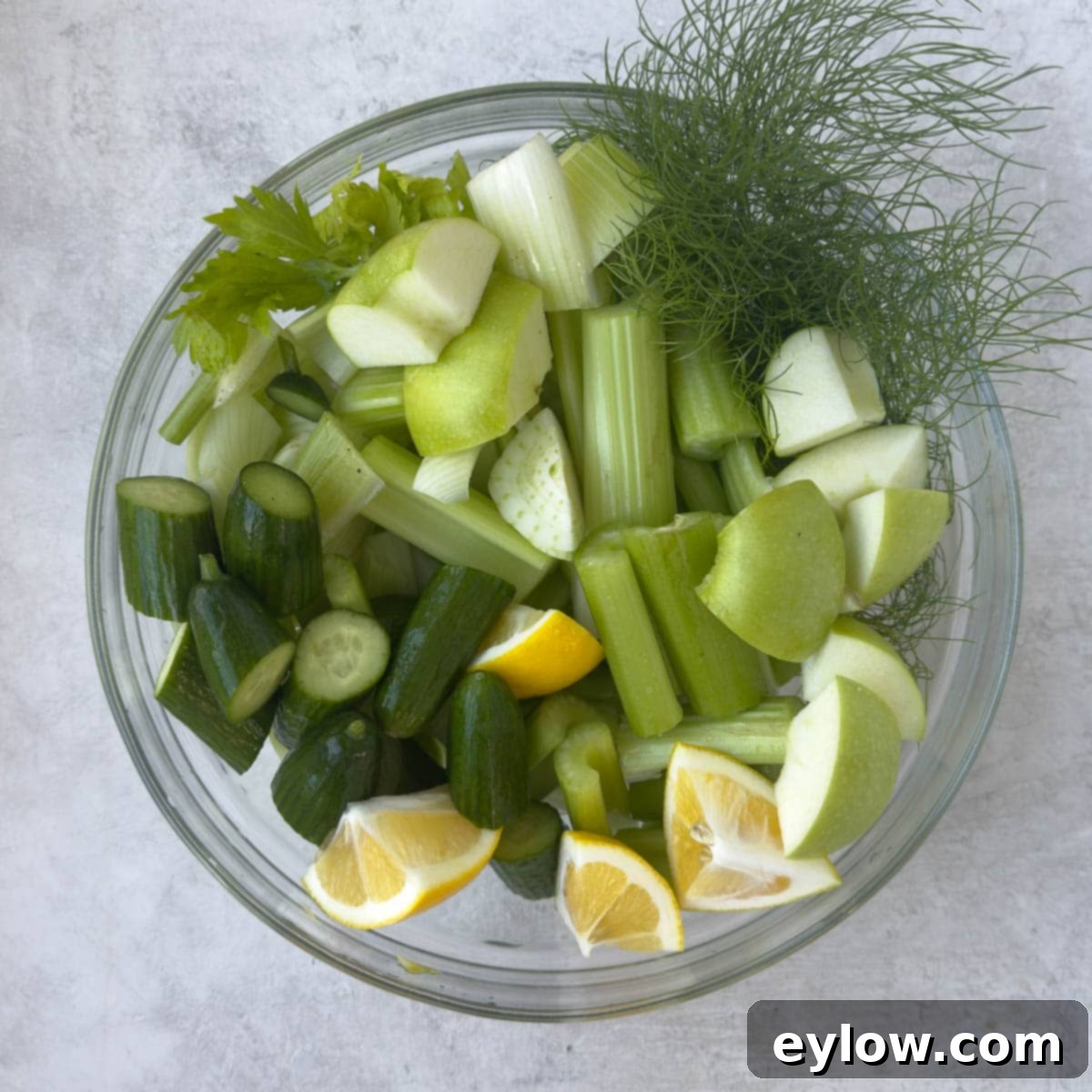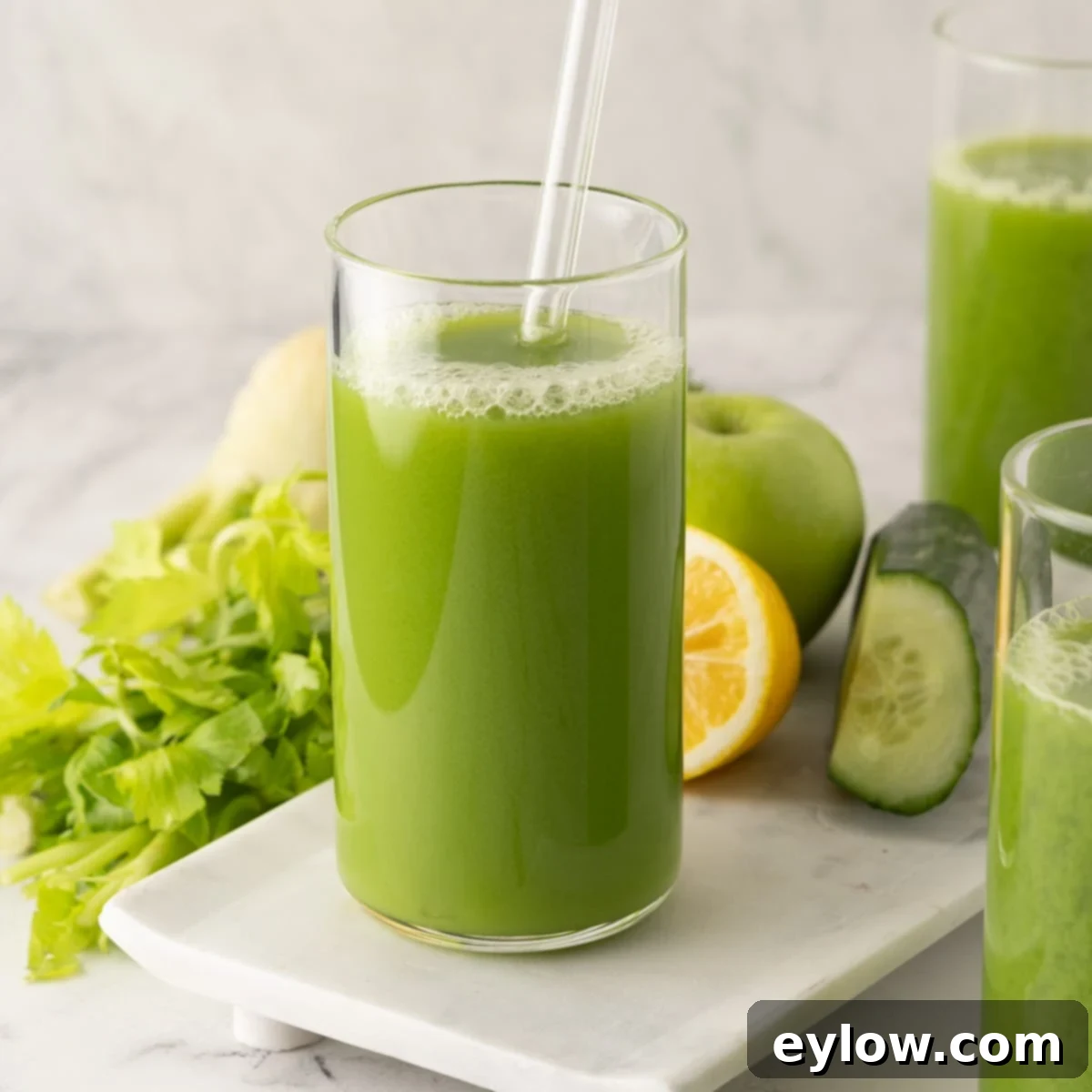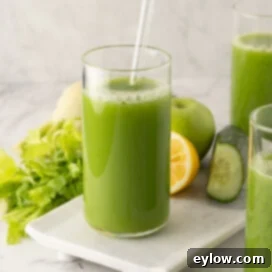Ultimate Celery Cucumber Juice: A Refreshing & Healthy Green Elixir Recipe
Imagine a drink that’s crisp, clean, and incredibly refreshing, much like the perfect iced tea, but with even more profound health benefits. We’re talking about homemade celery cucumber juice – a vibrant green elixir that promises to invigorate your senses and nourish your body from within. If you’re a fan of green juices or looking to incorporate more wholesome goodness into your daily routine, this recipe is an absolute must-try. It’s not just a drink; it’s a powerful blend of nature’s finest, designed to offer superior hydration, a rich array of essential vitamins, vital nutrients, and natural electrolytes. By making this fantastic celery cucumber green juice at home, you can easily boost your intake of nutrient-dense greens and experience a noticeable difference in your overall well-being.

One of the most compelling reasons to embrace this beautiful green cucumber juice recipe is its potent anti-inflammatory properties. Every ingredient plays a crucial role: celery, cucumber, lemon, and even the often-overlooked fennel are all renowned for their powerful anti-inflammatory compounds. In today’s fast-paced world, reducing inflammation is key to maintaining long-term health, and integrating a delicious, easy-to-make juice like this can be a significant step in the right direction.
Why You’ll Love This Healthy Green Juice Recipe
This celery cucumber green juice is more than just a tasty beverage; it’s a powerhouse of nutrition designed to support your body in numerous ways. Here are the top reasons why this recipe will quickly become a favorite in your juicing repertoire:
- Immune System Boost: This green juice provides a healthy boost for your immune system, thanks to its rich content of vitamins like C, A, and K, essential minerals such as potassium and calcium, and a robust profile of antioxidants. Vitamin C is well-known for its immune-supporting role, while Vitamin A contributes to healthy vision and cellular function. Vitamin K is vital for bone health and blood clotting, and the minerals help maintain fluid balance and nerve function.
- Easy Access to Ingredients: Celery and cucumbers are staples in most grocery stores and farmers’ markets, making them readily available year-round. This ensures that you can enjoy this refreshing juice whenever the craving strikes without having to search for exotic or hard-to-find produce.
- Effortless Green Veggie Benefits: For many, consuming enough green vegetables can be a challenge. Juicing offers a convenient and delicious way to pack a significant amount of green goodness into your diet. This recipe makes it an easy way to boost your daily intake of beneficial green nutrients without feeling like a chore. It’s a simple, effective method to enhance your nutritional intake.
- Natural Hydration: Both celery and cucumber boast extremely high water content, making this juice an excellent choice for rehydration, especially after a workout or on a hot day. Beyond just water, they provide natural electrolytes that help your body absorb and utilize fluids more effectively than plain water alone.
- Detoxification Support: The combination of ingredients in this juice, particularly the lemon and fennel, supports the body’s natural detoxification processes. They help cleanse the liver and kidneys, aiding in the elimination of toxins and promoting overall systemic balance.
- Anti-Inflammatory Powerhouse: As mentioned, every ingredient contributes to the anti-inflammatory profile of this juice. This makes it a fantastic choice for individuals looking to reduce systemic inflammation, which is often linked to various chronic health issues.
If you’re already a fan of invigorating green juices, you might also enjoy exploring these other delightful green smoothie recipes: our superfood blueberry green smoothie with spirulina, a refreshing green tea and avocado smoothie, or a truly delicious green smoothie recipe with mango for a touch of tropical sweetness. Each offers unique flavors and health benefits to diversify your green drink routine.
Essential Ingredients for Your Green Juice
While plain celery juice can be quite bitter for many palates, the magic happens when you create a juice blend. This recipe artfully combines celery with other complementary flavors, resulting in a wonderfully balanced and delicious green juice. The synergy of these ingredients not only enhances the taste but also amplifies the nutritional benefits.

- Cucumber: For this recipe, you can use a large English cucumber (also known as seedless or greenhouse cucumber), several Persian cucumbers, or traditional American or field cucumbers. All varieties work exceptionally well. Cucumbers are remarkable for their incredibly high water content, approximately 95% pure water, making them an unparalleled source of hydration for your juices. They also offer a mild, refreshing flavor that balances stronger ingredients.
- Celery: Select fresh, crisp celery heads that show no signs of browning or wilting. The amount you’ll need may vary slightly depending on the seasonal size of the celery heads. Like cucumbers, celery is composed of roughly 95% water, contributing significantly to the juice’s hydrating qualities. Celery is also known for its potential to support cardiovascular health and provide a good source of fiber (some of which remains in the juice).
- Lemon: If you’re fortunate enough to grow Meyer lemons, they are fantastic when in season, offering a slightly sweeter and more aromatic profile. Otherwise, standard grocery store lemons are perfectly fine and deliver that essential bright, zesty lift of flavor that green juices often need. Lemon juice and rind are packed with Vitamin C and other beneficial compounds, making them incredibly good for you and a great digestive aid.
- Apple: A tart, green Granny Smith apple is the ideal choice for juicing. Its lower sugar content compared to sweeter apple varieties helps maintain a healthy sugar balance in your juice, while still contributing a pleasant tang and a subtle sweetness that rounds out the flavors. Apples also bring their own host of antioxidants and vitamins to the blend.
- Fennel: Many people are initially surprised to find fennel in a green juice recipe, but it is truly terrific in juice blends. Juicing highlights its unique, subtle licorice-like flavor without it being overpowering. You can efficiently use the stalks and fronds for juicing, alongside the bulb, ensuring a no-waste approach. Fennel is a good source of a unique phytonutrient called anethole, which is recognized for its natural anti-inflammatory properties and its ability to aid digestion.
For precise measurements of each ingredient, please refer to the detailed recipe card provided further below. To ensure you’re getting the best possible juice and maximizing its health benefits, we highly recommend purchasing organic produce. This is especially crucial for organic celery and organic cucumbers, as they frequently appear on the EWG’s Dirty Dozen List – a valuable resource to consult when making your shopping choices to avoid pesticide residues.
Chef’s Tip: Don’t peel your lemons! Leave the lemon peel on. Why is this important? The peel contains a powerful compound called d-limonene. D-limonene is what gives citrus fruits their distinctive and wonderful aroma. It’s also found in the skin of limes, oranges, and other citrus varieties. As a potent antioxidant, d-limonene possesses significant anti-inflammatory properties. Furthermore, it’s recognized as a powerful anti-fungal and anti-microbial chemical, offering robust support for your liver’s natural detoxification processes. All these amazing benefits come from simply leaving the beautiful lemon peel intact! For more in-depth information, you can read this terrific article on the health benefits of d-limonene and another insightful piece by Wellness Resources.
Customize Your Juice: Substitutions and Variations
While the original recipe for celery cucumber juice is perfectly balanced, don’t hesitate to experiment with substitutions and variations to tailor the flavor to your preference or to utilize what you have on hand. Making it your own is part of the fun of home juicing!
- Fennel Alternative: If fresh fennel isn’t available or if you’re not keen on its subtle licorice flavor, simply skip it. You can compensate by adding a bit more cucumber to maintain the liquid volume and refreshing quality of the juice.
- Citrus Swap: For a slightly different tangy note, feel free to swap lime for lemon. Lime offers a distinct aromatic zest and similar health benefits, including a good dose of Vitamin C.
- Add Fresh Herbs: Boost the detoxifying power and introduce new layers of flavor by adding half a bunch of either Italian parsley or cilantro. Both are excellent detoxing herbs known for their chlorophyll content and ability to chelate heavy metals.
- Manage Sugar Content: If you’re concerned about natural sugar content or managing blood sugar levels, use only half of the apple. You can save the other half for your next juicing session, or simply omit it entirely for a less sweet, more vegetable-forward juice.
- Spice It Up with Ginger: A small knob of fresh ginger (about ½ to 1 inch) can add a wonderful zesty kick and additional anti-inflammatory benefits to your juice. Ginger is a fantastic digestive aid and provides a warming sensation, especially if you enjoy a little spice.
- Boost with Greens: Consider adding a handful of spinach or kale for an extra punch of leafy green nutrients. These mild greens blend seamlessly into the juice without drastically altering the core flavor profile.
For another healthy green juice recipe that brings a unique twist, try this invigorating green cabbage celery juice. Or, if you’re looking for something specifically formulated to aid in cleansing, our detox green juice is an excellent choice to support your body’s natural purification processes.
Step-by-Step Juicing Guide
Making your own celery cucumber juice at home is a straightforward process that yields incredibly rewarding results. Follow these simple steps to prepare your fresh, nutritious green elixir:



If you’re looking for another terrific recipe featuring the refreshing goodness of cucumber, be sure to try this delightful cucumber salad with feta and mint. It’s super refreshing, incredibly easy to make, and a perfect complement to any meal.
Chef’s Tip: Understanding Green Juices. Many people struggle to consume enough fruits and vegetables daily, making green juice a truly terrific and convenient addition to your diet. It’s crucial to remember that juicing does not replace eating whole fruits and vegetables; it’s a beneficial bonus. We still need the fiber provided by whole fruits and vegetables for optimal digestive health and satiety. However, by drinking green and other vegetable juices, you can consume a far greater concentration of the powerful phytonutrients that fruits and vegetables offer. These plant-based compounds are responsible for many of the incredible health benefits associated with a produce-rich diet, acting as antioxidants, anti-inflammatories, and immune system boosters. Think of juicing as a way to flood your body with these concentrated micronutrients.

Optimal Serving & Storage Tips
To truly maximize the benefits and enjoyment of your homemade celery cucumber juice, consider these serving and storage tips. The freshness of your juice directly impacts its nutritional value and vibrant taste.
I personally love to drink celery cucumber juice right out of the machine at room temperature, as this allows the natural flavors to truly shine. However, it is equally fantastic and wonderfully refreshing after being refrigerated. For optimal nutrition, it’s generally recommended to drink your fresh juice within 15-20 minutes after pressing. This is when the enzymes and micronutrients are at their most potent.
Regarding storage, the lifespan of your fresh juice depends significantly on your juicer. Juices made with a high-quality cold-press or masticating juicer, which minimize heat and oxidation during extraction, tend to hold with minimal nutrient loss for a longer period – typically between 24 to 72 hours. Juices from centrifugal juicers, which introduce more air and heat, should ideally be consumed sooner, within 24 hours.
Important Health Note: If you are currently taking blood thinning medications, it’s crucial to be aware that green juices, like this celery cucumber blend, are naturally high in Vitamin K. Vitamin K plays a vital role in blood clotting and can interact with certain medications. Always check with your healthcare provider or a qualified nutritionist before starting a regular juicing habit to ensure it aligns with your individual health needs and medication regimen.
Chef’s Tip: Smart Bottling for Freshness. If you plan to store your juice, proper bottling is key to preserving its nutrition and extending its shelf life. When pouring your fresh juice into glass bottles or mason jars, ensure you fill them to the very top, leaving absolutely no air gap. If you find yourself a little short on juice to fill the bottle completely, simply add a small amount of filtered cold water to make up the difference. This crucial step significantly reduces oxidation, which is the primary cause of nutrient degradation in fresh juices, thereby preserving its beneficial compounds for longer.

For those serious about their juicing journey and interested in making larger batches that stabilize juices for up to 72 hours (allowing you to juice a few days at a time), I highly recommend you check out this juicer from Tribest. The Tribest Greenstar Elite is the model I use most of the time, and it consistently appears on lists of the best juicers available, particularly for its ability to preserve nutrients. Regardless of your juicer choice, always make it a priority to buy organic vegetables for juicing to minimize exposure to pesticides and maximize nutrient intake.
Common Questions About Celery Cucumber Juice
Here are answers to some of the most frequently asked questions about making and enjoying celery cucumber juice:
For juicing, you have several excellent options, and almost any variety of dark green cucumber will work wonderfully. Popular choices include English cucumbers (also known as hothouse, seedless, and burpless cucumbers), the smaller, flavorful Persian cucumbers, or regular field/American cucumbers (which are often used for pickling). English cucumbers are long, slender, and can be slightly more bitter, which is actually beneficial for juicing as bitter flavors and bitter greens are known to support the natural detoxification functions of the liver. Choose what’s freshest and most accessible to you.
There’s generally no need to peel cucumbers before juicing. The skin of a cucumber is packed with a significant amount of nutrients, including vitamins, minerals, and antioxidants. Peeling would mean discarding many of these beneficial compounds. Just ensure you wash your cucumbers thoroughly, especially if they are not organic, to remove any dirt or surface residues.
For making cucumber juice and other vegetable and fruit juices, there are three common types of juicers to consider:
- Centrifugal Juicers: These are often more affordable and faster, using a spinning blade to extract juice. However, they introduce more oxygen and heat, which can lead to faster oxidation and nutrient loss.
- Cold-Press Masticating Juicers: These juicers operate at a slower speed, grinding and pressing produce to extract juice. This method minimizes heat and oxidation, preserving more enzymes and nutrients, and typically yields more juice, especially from leafy greens.
- Twin Gear Juicers: A sub-category of masticating juicers, twin gear models use two interlocking gears to crush and press produce. They are often considered the best for fibrous vegetables like celery, delivering the most nutrition for your money due to superior extraction.
Both centrifugal and masticating juicers do an acceptable job, but cold-press and twin gear juicers are superior in terms of nutrient preservation and yield. They are more of an investment, but many find them worthwhile. If you’re new to juicing, you might start with a less expensive centrifugal juicer to ensure you enjoy the habit, then consider investing in a different, more advanced model once you’re committed.
A fresh fruit and vegetable juice is best consumed within 15-20 minutes after pressing, ideally on an empty stomach if possible, for the fastest assimilation of nutrients. This is when the enzymes are most active and the nutritional value is at its peak. If immediate consumption isn’t possible, you can store your juice. To do so, fill glass bottles or jars to the very top, ensuring no air gap, and seal them with an airtight lid. Stored this way, the juice can typically last up to 24 hours. As mentioned in our serving tips, some advanced cold-press juicers can produce juices that maintain minimal nutritional loss for up to 72 hours when stored correctly, offering more flexibility for batch juicing.
Juice blends like this celery cucumber recipe are generally more palatable than single-ingredient juices because the flavors are balanced. However, if you’re not accustomed to drinking fresh fruit and vegetable green juices, they can indeed have a distinct, often less sweet, or even slightly bitter taste compared to commercial juices. To make the juice more palatable and enjoyable, you can try several strategies:
- Add more Lemon: The bright acidity of lemon can cut through bitterness and enhance overall freshness.
- Include Fresh Raw Ginger: A small piece of ginger adds a spicy warmth and can mask less desirable flavors.
- Incorporate Herbs: Cilantro or Italian parsley can add a fresh, vibrant, and cleansing note.
- Balance with Sweeter Vegetables: Juicing some carrots or green cabbage can introduce a natural sweetness without relying heavily on fruits.
- Adjust Apple Content: While we recommend Granny Smith for lower sugar, a slightly larger piece or a different apple variety can make the juice sweeter if needed.
- Dilute with Water: If the flavor is too intense, a splash of filtered water can help mellow it out.
Experiment to find the perfect balance that suits your taste buds!
Explore More Juicing Recipes
Embark on a deeper journey into the world of juicing with these insightful articles and delicious recipes. Whether you’re curious about specific ingredients or looking for new blends, we’ve got you covered.
If you’ve ever wondered whether the benefits of celery juice is hype or healing (often discussed in relation to Anthony William’s books), be sure to check out our dedicated article for some thought-provoking insights. Moreover, for a comprehensive overview and all kinds of practical tips, answers, and detailed information on topics like weight loss, reducing blood pressure, and other possible health benefits of juicing, make sure to read this essential guide to juicing with vegetables. It’s a fantastic resource for both beginners and experienced juicers alike.
- Green Juice with Cabbage and Celery
- Carrot Ginger Juice Recipe
- Beet Juice Recipe
- Watermelon Cucumber Juice
⭐️ Did You Make This? We’d Love to Hear From You!
If you take the plunge and make this refreshing celery cucumber juice, please take a moment to leave a comment below and let me know how you liked it! I genuinely read every single comment, and your feedback is incredibly valuable. If you absolutely loved it, please consider giving it a 5-star rating! Your ratings and comments truly help other readers discover and enjoy this wonderful recipe.
📖 Recipe: Celery Cucumber Juice

Celery Cucumber Juice
Sally Cameron
Pin Recipe
Equipment
-
Electric Juicer (preferably masticating or cold-press) this is the one I use
Ingredients
- 1 ½ heads celery about 14 stalks or ribs, preferably organic
- 1 English cucumber or 3-4 Persian cucumbers or 2 field cucumbers, preferably organic
- 1 small fennel bulb with stalks and fronds, preferably organic
- 1 Granny Smith apple preferably organic
- 1 small lemon preferably organic, leave peel on
Instructions
-
Thoroughly wash all your produce. Once cleaned, chop the vegetables and apple into pieces that are suitable for your juicer’s feed chute, following the guidelines in your juicer’s manual. Remember to core the apple and discard the seeds.
-
Chop the fennel, including its stalks and fronds, into smaller pieces, as it is a firm vegetable. Cut the lemon into quarters – there’s no need to peel it, as the peel contains beneficial nutrients like d-limonene. Process all ingredients through your juicer according to its directions, alternating between softer and harder produce for optimal juice extraction. Enjoy your fresh juice immediately.
If your juice contains any pulp and you prefer a smoother texture, you can either enjoy it as is with a little pulp or strain it through a fine-mesh strainer or sieve for a clearer consistency.
Notes
- Lemon Peel Benefits: Always leave the rind on the lemon when juicing, especially if organic. The peel is a fantastic source of d-limonene. This compound acts as a powerful antioxidant, is strongly anti-inflammatory, and boasts potent anti-fungal and anti-microbial properties. Additionally, it provides excellent support for liver detoxification.
- Reduce Natural Sugar: If you are mindful of your natural sugar intake or have blood sugar concerns, use only half an apple for the recipe. You can save the other half for your next juicing session, or opt for a whole apple if desired.
- Boost with Herbs: Enhance the detoxifying properties and add a fresh, vibrant flavor by incorporating half a bunch of either Italian parsley or cilantro. Both herbs are known for their cleansing benefits.
- Add a Ginger Kick: For a delightful zesty flavor and additional anti-inflammatory support, consider adding a small knob of fresh raw ginger. Start with about ½ to 1 inch, but be mindful not to overdo it, as ginger can be quite spicy!
- Optimal Storage: For storing juice, fill glass bottles completely to eliminate air pockets, which helps reduce oxidation and preserve nutrients. Store in the refrigerator.
- Consult Healthcare Provider: If you are on blood-thinning medication, consult your doctor before regularly consuming green juices due to their natural Vitamin K content.
